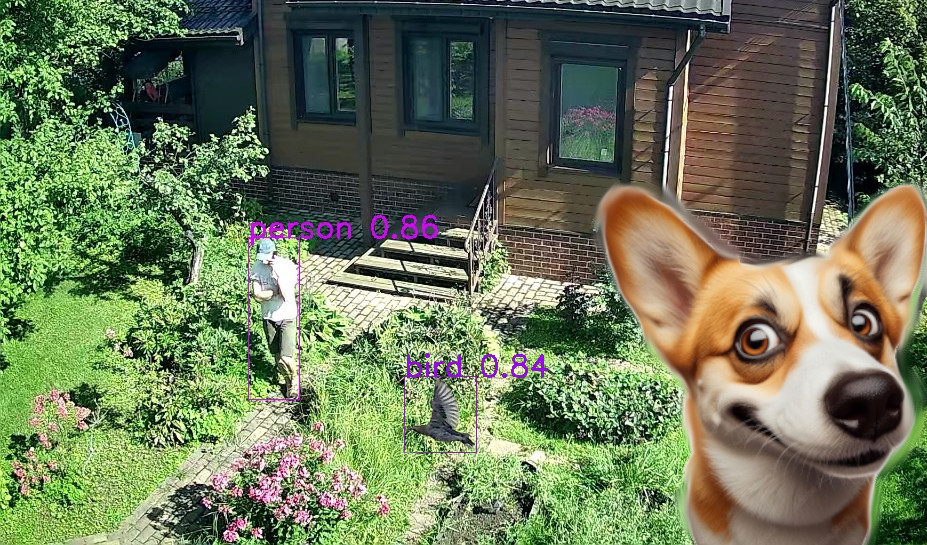
Light-weight framework for Objects AI-detection with Live-Cameras (USB/IP) and Telegram-bot notifications. Use Yolo or adjust for you own AI-models support and catch the best shot!
Installation for Linux, Win or Mac is similar. Jetson TX1/2 (Ubuntu18/Arm/Python3.6) works too! The three main steps are below:
1. Download the watchdog and install required python-modules (linux-shell command):
cd /home/user
git clone https://github.com/agudym/watchdog.git
cd watchdog
python -m pip install -r requirements.txt 2. Get AI-detector and weights/configuration, YOLOv9 (2024) is supported at the moment. Or simply adjust detector.py for your model.
[Optional] For GPU(Nvidia CUDA) accelerated detection with Torch follow instructions.
cd ..
git clone https://github.com/WongKinYiu/yolov9.git
cd yolov9
wget https://github.com/WongKinYiu/yolov9/releases/download/v0.1/yolov9-m-converted.pt Add 2 new paths to config.json (see below an example). Then run python -m watchdog.detector config.json <path to test image dir> to verify that detection works.
3. [Optional] Register your watchdog-bot in Telegram: basically, send @BotFather the command /newbot to get token-string (keep it SECRET!).
3.1. Start conversation with your new bot in Telegram (it won't respond so far, though).
3.2. Copy-paste the token to the configuration file config.json.
3.3. Run python -m watchdog.bot configs/config.json to initialize chat-id in the config.
Alright, the environment is set!
Last but not least is to configure the cameras. USB or IP, one or many - doesn't matter. First of all it's recommended to use VLC to check the camera (ip-connection). Then fill the missing fields in configs/config.json.
Below is the complete example. Follow the descriptions there to setup your own configuration and run python -m watchdog.camera configs/config.json to make sure that images are captured correctly.
When the missing fields from configs/config.json are filled, run the Watchdog by executing the main script, e.g.:
cd /home/user/watchdog
python -m watchdog.main configs/config.jsonOr, for example, run a detached process via temporary ssh-connection (linux-shell command):
nohup python -m watchdog.main configs/config.json &> log_nohup.txt &That's it! Now watchdog will record activity and Telegram-bot will speak and report!
To interrupt the watchdog-process - create an empty file with the name stop in the output_path, e.g. (linux-shell command):
touch /home/user/recordings/stop// Comments must be removed before use!
{
"version": "0.1.0",
"Watchdog":
{
// Output LOCAL directory with recorded images and logs
"output_path" : "/home/user/recordings",
// Each camera save jpg images with given frequency (even if nothing is detected), in seconds
"img_log_timeout" : 300,
// Log everything to the file
"verbose" : true
},
"Detector" :
{
"Init" :
{
// Path to the Yolo library (current version doesn't support installation)
"yolo_lib_path" : "/home/user/yolov9",
// Path to the model weights
"checkpoint_path" : "/home/user/yolov9/yolov9-m-converted.pt",
// Resolution used for faster inference, so far it's (1920, 1080) * k, k = 1024 / 1920. Adjust if cameras have another aspect (padding might be needed, e.g. w/h mod 32 == 0)
"img_width_height_channels" : [1024, 576, 3],
// Processing unit: auto, cpu, cuda
"device_switch" : "auto",
// Switch to lighter (fp32 -> fp16) computations (if possible)
"is_model_fp16" : false
},
// All detectable classes/object categories (comma-separated), e.g. for Yolo it's 80 categories from COCO 2017 dataset http://cocodataset.org
"categories_all" : "person,bicycle,car,motorcycle,airplane,bus,train,truck,boat,traffic light,fire hydrant,stop sign,parking meter,bench,bird,cat,dog,horse,sheep,cow,elephant,bear,zebra,giraffe,backpack,umbrella,handbag,tie,suitcase,frisbee,skis,snowboard,sports ball,kite,baseball bat,baseball glove,skateboard,surfboard,tennis racket,bottle,wine glass,cup,fork,knife,spoon,bowl,banana,apple,sandwich,orange,broccoli,carrot,hot dog,pizza,donut,cake,chair,couch,potted plant,bed,dining table,toilet,tv,laptop,mouse,remote,keyboard,cell phone,microwave,oven,toaster,sink,refrigerator,book,clock,vase,scissors,teddy bear,hair drier,toothbrush",
// Categories for notifications (images with the objects saved asap on the disk and send via bot)
"categories_notify" : "person,bird,cat,dog",
// How confident the detector must be to signal/alarm with the bot, 0 < confidence_threshold < 1
"confidence_threshold" : 0.8,
// Merge close bounding boxes represented with normalized 4-vector (x_low, y_low, x_high, y_high) in [0,1]^4
"bbox_merge_dist" : 0.01
},
"Bot" :
{
// How often the watchdog can bother via Telegram
"bot_warning_timeout" : 30,
// The SECRET! token received from the @BotFather
"token" : "1234567890:AaBbCcDdEeFfGg123AaBbCcDdEeFfGg",
// Your bot-chat identifier (aquired from bot.py)
"chat_id" : "987654321"
},
"Cameras":
[
// Main camera setting, it's address in the system/network (supported by OpenCV's cv::VideoCapture):
// 1. USB camera integer-index, e.g. integer 0 or "/dev/video0"
// 2. RTSP address, e.g. "rtsp://192.168.1.101"
// 3. GStreamer pipeline
// 4. OR! PATH to an existing DIRECTORY with Images (Good for debugging)
{
// USB camera
"uri": 0,
// Camera alias for logging, e.g. "cam1", "cam_home", "cam_street"
"name": "usb0",
// Number of frames per second (for data-polling and cpu-resource preservation)
"fps": 30.0,
// Initialize, capture, release time limit in seconds (before reset)
"timeout_err": 30,
// Number of failed frames before reset
"count_err" : 100
},
{
// The most universal approach for IP cameras supporting RTSP
"uri": "rtsp://192.168.1.101",
"name": "ip1",
"fps": 15.0,
"timeout_err": 30,
"count_err" : 100
},
{
// Manually set GStreamer-pipeline for "older" camera with h264 stream for Jetson TX1/2 (hardware decoding without buffering)
"uri": "rtspsrc location=rtsp://192.168.1.101 ! rtph264depay ! nvv4l2decoder ! nvvidconv ! video/x-raw, width=(int)1920, height=(int)1080, format=(string)BGRx ! videoconvert ! appsink max-buffers=1 drop=True",
"name": "ip2_h264",
"fps": 25.0,
"timeout_err": 30,
"count_err" : 100
},
{
// Manually set GStreamer-pipeline for h265 stream for Jetson TX1/2
"uri": "rtspsrc location=rtsp://192.168.1.102 ! rtph265depay ! decodebin ! nvvidconv ! video/x-raw, width=(int)1920, height=(int)1080, format=(string)BGRx ! videoconvert ! appsink max-buffers=1 drop=True",
"name": "ip2_h265",
"fps": 25.0,
"timeout_err": 30,
"count_err" : 100
}
// more cams go here ...
]
}Setting up hardware-accelerated decoding could be tricky but necessary to avoid lags or delays during streams processing. Use gstreamer application to find the right pipeline, e.g. linux-shell command (for Jetson TX1/2):
gst-launch-1.0 rtspsrc location=rtsp://192.168.1.101 ! rtph264depay ! nvv4l2decoder ! nvvidconv ! video/x-raw, 'width=(int)1920, height=(int)1080, format=(string)BGRx' ! videoconvert ! nv3dsink max-buffers=1 drop=TrueAlso specific build of OpenCV with GStreamer support might be required. For Jetson TX1/2 follow instructions.
The library and it's sources are released under the MIT License.